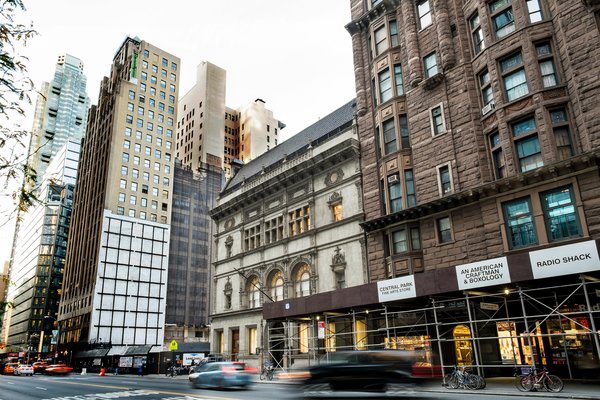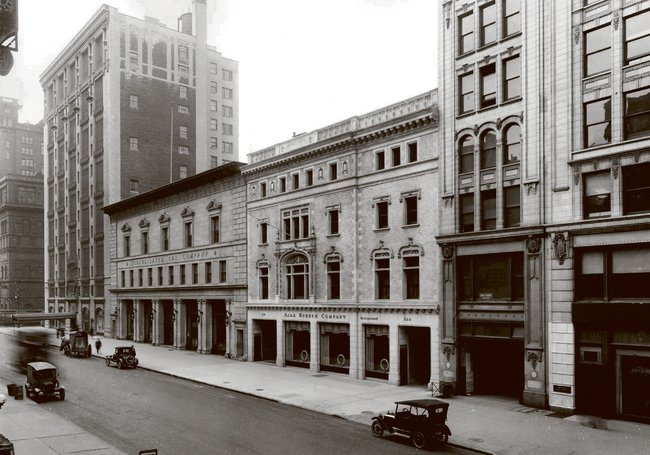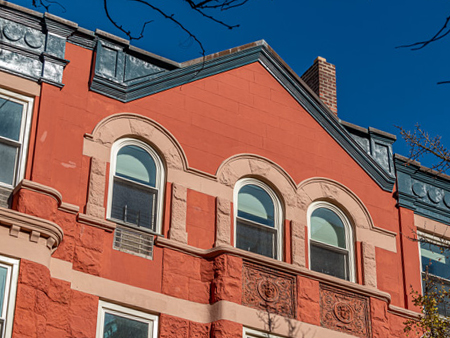Cristopher Gray reports for The New York Times.
[Ian Douglas for The New York Times]
The developer Extell now has the go-ahead from the Landmarks Preservation Commission to cantilever a 1,400-foot tower over the Art Students League at 215 West 57th Street, which will create, certainly, a beanstalk presence on what was already a thoroughly jumbled block.
Just how this short section of 57th between Broadway and Seventh Avenue became home to so many disparate institutions — the league, apartment buildings like the Osborne and car-related businesses like the old General Motors factory at Broadway — is a good question. The architectural mix, uncommon in Manhattan, came about as three distinct kinds of development moved in from three directions.
In 1880 this block was practically terra incognita, with just a few miscellaneous structures. Two blocks east, the intersection of 57th Street and Fifth Avenue was on its way to becoming a nexus of mansions, and 15 blocks south, what was still Longacre Square (soon Times Square) had emerged as a center for carriage manufacture.
[Museum of the City of New York]
Within a few years the Wyoming, the Ontiora and other apartment houses also rose on Seventh, and ultimately the stone-dealer Thomas Osborne decided to try his hand at this new type of multiple dwelling. His 1885 Osborne, a veritable brownstone quarry of 14 floors at the northwest corner of 57th, was one of the biggest of the crop.
The seed of innovation does not always find fertile ground, and The Real Estate Record and Guide saw “nothing architecturally interesting” about Osborne’s effort. A further slap in the face came when Osborne lost his vertical advertisement through foreclosure. However, it was the first of several apartment-house place markers on this block of 57th Street, including the Rodin Studios, on the southwest corner of Seventh, as well as others nearby, like the Alwyn Court at 58th Street.
A second thread of development arrived in 1892, when the American Fine Arts Society built 215 West 57th, the structure now known as the Art Students League. The society was a consortium of art organizations that banded together in 1889, and in moving to this block extended a line of ateliers on West 57th Street, like the Rembrandt and Sherwood Studios, and also Carnegie Hall, begun at Seventh and 57th in 1889.
A relation of the society’s was the lacy Gothic American Society of Civil Engineers, at 220 West 57th Street, built in 1897 and occupied for years by Lee’s Art Shop, which has preserved many of the interior details.
The final part of the transformation was the northward movement of the carriage operations of Longacre Square along Broadway. This was first felt in 1902 at midblock, next to the Art Students League, with Frank Gould’s colossal, banklike indoor riding ring, long ago demolished.
Peerless and Demarest, builders of horse-drawn and motorized vehicles, followed, and by 1910 had erected their Gothic-style white terra-cotta factory and showroom — later owned by General Motors — at the southeast corner of Broadway and 57th. At the northeast corner, Fiat took over a four-level store and showroom.
Almost simultaneously the Chicago architect Howard Van Doren Shaw designed a building with an unusual double façade for the L-shaped plot fronting on both Broadway and 57th.
By this time the block had just a few available plots, including one at No. 218 on the south side for which, in 1916, Consolidated Gas had Warren & Wetmore design its three-story limestone showroom. Although a commercial enterprise, the building certainly had a civic grandeur. It was torn down years ago.
In the 1990s the Art Students League declined two offers to build a tall building over its rear parcel. But the offer of $20 million for its air rights from Extell Development was persuasive, and now plans call for the league building to have a skinny pencil-case tower cantilevered overhead.
The Extell project would not be possible without the commission’s astonishing move of making a landmark of the Broadway frontage of the Shaw building while leaving the 57th Street bay, essentially identical to the one on Broadway, up for grabs. And grabbed it the developer has; the site is now cleared.
We have, then, a New York block, a sort of architectural loom on which three distinct strands coming from three directions were woven into a single fabric — where from now on it appears the only place to go may be straight up.





